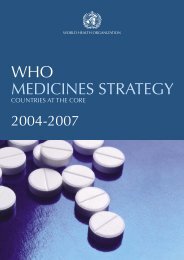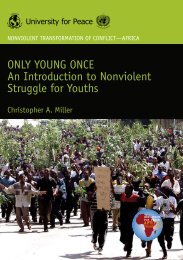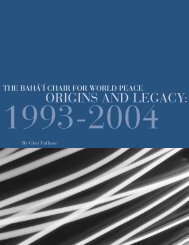environmental degradation as a cause of conflict in - Steiner Graphics
environmental degradation as a cause of conflict in - Steiner Graphics
environmental degradation as a cause of conflict in - Steiner Graphics
Create successful ePaper yourself
Turn your PDF publications into a flip-book with our unique Google optimized e-Paper software.
2. Agriculture (Farm<strong>in</strong>g)Crop farm<strong>in</strong>g is the ma<strong>in</strong> economic activity for more than eighty percent <strong>of</strong> Darfur’spopulation. The cultivation <strong>of</strong> millet, sorghum and other c<strong>as</strong>h crops (groundnuts,sesame etc) is essential for food and economy <strong>of</strong> the population. Millet is thestaple food for more than seventy-five percent <strong>of</strong> the population and is cultivatedthroughout Darfur, especially <strong>in</strong> the sandy soils and clay soils that could be exploitede<strong>as</strong>ily by manual labour. In turn sorghum is the staple food for the population<strong>in</strong> the west and the south <strong>of</strong> the region. It is cultivated <strong>in</strong> the wadi beds, lightclay and gardud soils. The cultivation <strong>of</strong> these crops h<strong>as</strong> cont<strong>in</strong>ued for hundreds<strong>of</strong> years <strong>in</strong> Darfur. The productivity <strong>of</strong> these crops is dependent on the ra<strong>in</strong>fall andnatural land fertility.In turn, the demand for the agricultural crops h<strong>as</strong> <strong>in</strong>cre<strong>as</strong>ed parallel to the <strong>in</strong>cre<strong>as</strong>e<strong>in</strong> the population. Therefore, what are the changes that have taken places<strong>in</strong>ce the beg<strong>in</strong>n<strong>in</strong>g <strong>of</strong> 1960s? What h<strong>as</strong> been the effect <strong>of</strong> the droughts thatstarted <strong>in</strong> the beg<strong>in</strong>n<strong>in</strong>g <strong>of</strong> seventies? Productivity and production <strong>of</strong> the ra<strong>in</strong> fedcrops decl<strong>in</strong>ed due to the decl<strong>in</strong>e <strong>of</strong> the ra<strong>in</strong>fall <strong>in</strong> quantity, distribution and <strong>in</strong>tensity.For compensation <strong>of</strong> the decl<strong>in</strong><strong>in</strong>g production, horizontal expansion <strong>of</strong> farm<strong>in</strong>gbecame an option for the farmers. In turn, the average land hold<strong>in</strong>gs per householdor person have decre<strong>as</strong>ed due to population <strong>in</strong>cre<strong>as</strong>e.Although there are no systemic and accurate <strong>of</strong>ficial productivity figures fromDarfur <strong>in</strong> the period <strong>of</strong> the sixties to the late eighties, b<strong>as</strong>ed on <strong>in</strong>terviews withsome farmers, the figures below <strong>in</strong>dicate the changes <strong>in</strong> both area and productivity.Yaqub Ahmed is a farmer <strong>in</strong> qoz soils <strong>in</strong> the western part <strong>of</strong> al-F<strong>as</strong>hir; his farm area is 60ımokhamus (5046 square meters). In 1968 he cultivated 12 mokhamus and the yield w<strong>as</strong>84 sacks <strong>of</strong> millet (100 Kg), i.e. 800 Kg per mokhamus.In 1974 he cultivated 25 mokhamus and the yield w<strong>as</strong> 43 sacks, i.e. 170 Kg per mokhamus.In 1984 the entire plot w<strong>as</strong> cultivated and the yield w<strong>as</strong> 12Kg per mokhamus.From 1999, 2000, 2001, 2002, 2003, the crop harvest <strong>as</strong>sessments carried out by theAgricultural Plann<strong>in</strong>g Unit (APU) <strong>of</strong> the State M<strong>in</strong>istry <strong>of</strong> Agriculture and Natural Resourcesfigured the follow<strong>in</strong>g productivity results: 65, 45, 23, 45 and 11 Kg per mokhamus respectivelyfor the same area. Moreover, it is worth not<strong>in</strong>g that this area <strong>of</strong> the qoz w<strong>as</strong> one <strong>of</strong>the 11 animal routes for nomads before 1962 and s<strong>in</strong>ce became agricultural land, and dueto cont<strong>in</strong>uous farm<strong>in</strong>g, droughts and pests etc., the productivity <strong>of</strong> millet and the graz<strong>in</strong>gcarry<strong>in</strong>g capacity have progressively decl<strong>in</strong>ed.36











